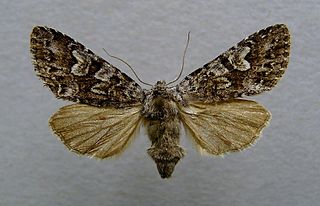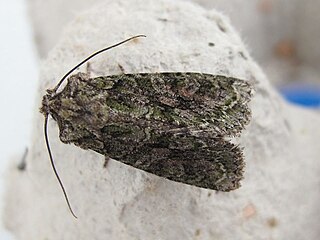
The marbled beauty is a moth of the family Noctuidae. The species was first described by Johann Siegfried Hufnagel in 1766. It is an abundant species throughout most of Europe east to the Urals, and it is probably the most common lichenivorous moth of the Palearctic realm.

Halpe homolea, the Indian ace or Ceylon ace, is a butterfly belonging to the family Hesperiidae.

Parnassius felderi, the Felder's Apollo, is a high-altitude butterfly which is found in Amur, Ussuri and China, North Korea and Japan. It is a member of the snow Apollo genus (Parnassius) of the swallowtail family, (Papilionidae).

Catocala sponsa, the dark crimson underwing, is a species of moth of the family Erebidae. It is found in Europe, North Africa and from Anatolia up to the Caucasus.

Anaplectoides prasina is a species of moth of the family Noctuidae. It is found in both the Palearctic and Nearctic realms.

Papestra biren, the glaucous shears, is a moth of the family Noctuidae. The species was first described by Johann August Ephraim Goeze in 1781. It is found in most of Europe, but not in the southern parts of the Iberian Peninsula, Italy and Greece. Outside of Europe it is found in Kashmir and through the Palearctic to Siberia, Central Asia, Amur, Kamchatka, the Russian Far East and Japan. It was introduced in Newfoundland in 1935 and has since then extended its range ever more southward within North America partly overlapping with Papestra quadrata(Smith, 1891). It rises to 2200 m above sea level in the Alps.

Apamea anceps, the large nutmeg, is a moth of the family Noctuidae. The species was first described by Michael Denis and Ignaz Schiffermüller in 1775.

Dryobotodes eremita, the brindled green, is a moth of the family Noctuidae. The species was first described by Johan Christian Fabricius in 1775. It is found in most of Europe, east to Turkey.

Megalopyge is a genus of moths in the family Megalopygidae.
Megalopyge braulio is a moth of the Megalopygidae family. It was described by Schauss in 1924. It is found in Paraguay.
Megalopyge torva is a moth of the family Megalopygidae. It was described by Schaus in 1912. It is found in Costa Rica.
Megalopyge vulpina is a moth of the family Megalopygidae. It was described by William Schaus in 1900. It is found in Brazil.
Megalopyge obscura is a moth of the Megalopygidae family. It was described by Schaus in 1905. It is found in French Guiana.
Megalopyge ovata is a moth of the Megalopygidae family. It was described by Schaus in 1896. It is found in Brazil.
Megalopyge chrysocoma is a moth of the Megalopygidae family. It was described by Gottlieb August Wilhelm Herrich-Schäffer in 1856. It is found in Venezuela.
Megalopyge defoliata is a moth of the Megalopygidae family. It was described by Francis Walker in 1855. It is found in Mexico.
Megalopyge ravida is a moth of the family Megalopygidae. It was described by Herbert Druce in 1887. It is found in Mexico.
Megalopyge salebrosa is a moth of the Megalopygidae family. It was described by James Brackenridge Clemens in 1860. It is found in Mexico and Guatemala.

Podalia orsilochus is a moth of the Megalopygidae family. It was described by Pieter Cramer in 1775. It is found in Mexico, Costa Rica, Brazil, Guyana and Venezuela.
Podalia walkeri is a moth of the Megalopygidae family. It was described by Carlos Berg in 1882 and is found in Brazil.









